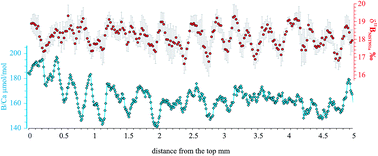Accurate and precise microscale measurements of boron isotope ratios in calcium carbonates using laser ablation multicollector-ICPMS†
Abstract
The boron isotope compositions (δ11B) of biogenic carbonates have proven to be an invaluable tool for investigating changes in ocean carbonate chemistry, especially the impacts of declining seawater pH due to rising levels of atmospheric CO2. Accurate, high precision boron isotopic measurements, however, remain analytically challenging with conventional approaches being extremely time consuming and labour intensive. Here we present a new analytical approach for high precision accurate measurements of boron isotope compositions in biogenic carbonates. We show that a laser ablation MC-ICPMS system equipped with 1013 Ω amplifiers provides a powerful tool for determining micro-scale δ11B values with an internal precision of ≤0.15‰ (2SD) and a total long-term accuracy of better than 0.22‰, which is equivalent to or better than those of conventional solution-based methods. This accuracy is achieved by careful subtraction of baseline interference around the masses of 10B and 11B, which arises from matrix-specific scattered Ca, C, and O ions. We also report detailed protocols for time-response corrections of transient signals in biogenic carbonates, essential for high precision boron isotopic measurements when using 1013 Ω amplifiers. The overall veracity of our laser ablation MC-ICPMS method is further demonstrated by the isotopic variability observed at macro- (mm) and micro-scales (μm) in both calcite and aragonite biogenic minerals. An aragonite deep-sea coral, Desmophyllum dianthus, is shown to preserve large (up to 6‰) variations in δ11B accompanied by near synchronous changes in B/Ca. This variability is excessive compared to that expected for the relatively stable carbonate ion system of deep-ocean water and is therefore attributed to isotopic and elemental fractionation of B during coral biomineralisation. In contrast, cyclic 2.5‰ variability is found in the sclerosponge Ceratoporella nicholsoni, which can be directly linked to seasonal changes in seawater pH. These examples highlight the power of laser ablation MC-ICPMS and its ability to accurately and precisely recover small environmental signals in boron isotopes. We thus show that these significant improvements in both the internal precision and now long-term accuracy and reproducibility of laser ablation MC-ICPMS, together with its microscale analytical capabilities and relatively rapid ease of operation, have the potential to revolutionise the study of boron isotope systematics in biogenic carbonates.



 Please wait while we load your content...
Please wait while we load your content...